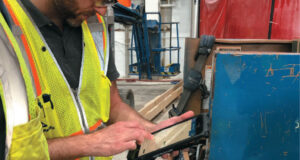The first paper mill I visited was Garden State Paper in Garfield, NJ, in 1975. I still had two years of engineering school ahead of me. The mill was modern for its time and made 100 percent recycled newsprint with a proprietary deink process. I wore a tie, khakis, and dress shoes while being toured around from the basement to the mezzanine. Yes, mill visitors and many vendors wore ties.
My mill dress code has evolved since then, mostly due to changes in mill safety requirements and the work I was doing. Performing vacuum-dewatering studies required more hands-on work and many opportunities to get dirty … or hurt. I didn’t begin wearing jeans in a mill until 20 years ago.
As my work clothes and safety gear evolved over almost 50 years, I have enjoyed visiting about 350 mills in 11 countries. This has given me an extensive mental database including knowledge of equipment, processes, mill management and operation styles, and relationships between positive safety results, positive operation, and mill efficiency results. I have also learned each mill has a unique culture that affects all measurable performance results.
When visiting a mill now, I enjoy seeing the “traffic light on green” along with the ongoing count of safe days since the last mill injury. I really appreciate seeing safety plaques stating the mill has reached a million, or more, safe man-hours. These safety results are telling me that the mill is well-managed and that my upcoming study should go well.
Remember the “Ear Plug Theory”? (Visit www.dougsweet.net to download that article.) There is a definite positive relationship between clean, safe mills and high operating efficiencies. Fewer discarded earplugs between the operating floor and parking lot typically means the mill just runs better and is safer.
However, not all mills have evolved positively or equally. I still find myself in situations where safety efforts are not fully embraced. I completed a recent study with an exit meeting with mill management where I described a safety concern about slippery algae growing on the floor around the vacuum pumps. I commented that leaking water from packing and vacuum pump discharges were keeping the area constantly wet and the algae had become a hazard.
Surprisingly, I was told that I wasn’t supposed to be walking in that area. I was surprised that, rather than note a visitor’s concern with a safety-related item, the response was “avoid the unsafe situation.”
While I have your attention, let me suggest an important added step to an existing safety practice used by every mill. That practice is the use of yellow and red warning tape to indicate specific areas in a mill where caution is required. We know yellow warning tape means the area may be entered, but hazard awareness and caution must be exercised. Red warning tape designates an unsafe, hazardous area where entry is completely restricted.
My suggestion: require logging in when yellow and red hazard tape is used, including basic information and the date the tape was installed. Then, after the hazard has been resolved, the tape can be removed and noted in the safety log. The purpose of this added and simple step is to create history of the event where this tape was added in the mill. Often, the tape will be used and removed within a few hours or a few days.
Let me explain why this new procedure is important. I have experienced being in a hazard area unknowingly because the tape had been there so long that it fell down and was covered in dried stock, muddy water, dirt, etc. Each time I could have been injured. In each case, after the “near miss” incident, I found red or yellow tape on the ground and barely visible. In one case, no writing appeared on the tag hanging on the tape—it had been there so long that the words had faded.
Revising safety practices to include recording when hazard tape was used should include a step during safety meetings to review logged-in items. Cases where weeks or months may have lapsed since last log-in should prompt someone to inquire if the hazard was ever resolved or eliminated.
I’m hopeful that this article can spark discussion in mill safety offices and within the TAPPISAFE community to improve safety practices. We can all agree that the goal is to prevent injuries so everyone can go home healthy every day.
 Paper 360
Paper 360

